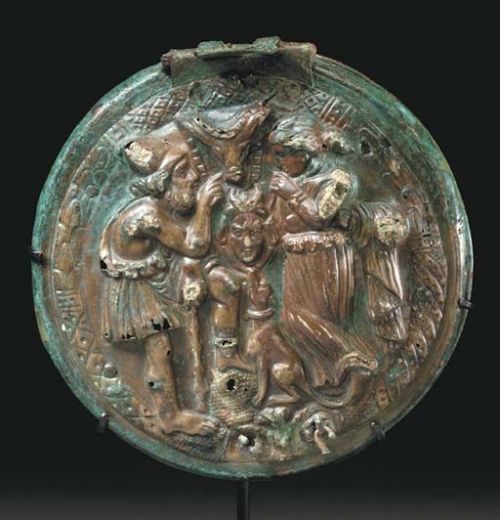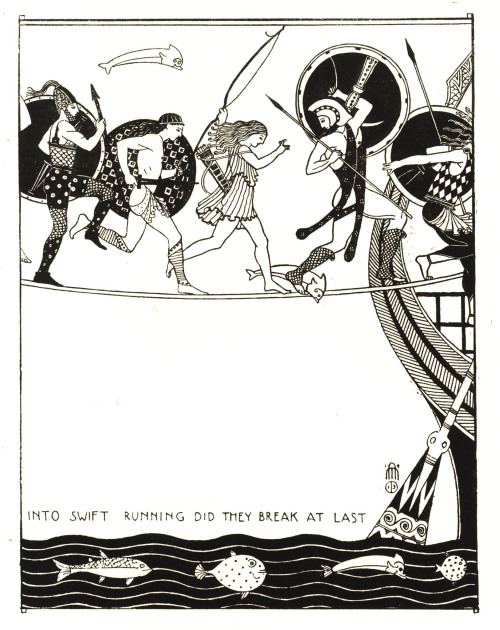Yet Think, A Day Will Come, When Fate's Decree And Angry Gods Shall Wreak This Wrong On Thee; Phoebus
Yet think, a day will come, when fate's decree And angry gods shall wreak this wrong on thee; Phoebus and Paris shall avenge my fate, And stretch thee here before the Scaean gate.
More Posts from Phaespxria and Others


homophrosyne

sketch

Clytemnestra for @lesbiancassius (my part of the trade for an incredible alcibiades/socrates fic ;__;)
New infographic/poster/thing: Ancient Greek Pottery

This is my last big project of the holidays as it’s Back To School on Monday!
More info and the full version on GreekMythComix.com
Have a great Back To School!
Any of you ever seen this painting?

It's "Andromache" by Rochegrosse and it shows the moment where Andromache is violently torn away from her child Astyanax at the end of the Trojan War. Odysseus is watching the scene from the top of the stairs, waiting for the child to throw it from the ramparts of Troy.
I've seen the original a couple years ago in Rouen, France and let me tell you, I'm not much of an art enthusiast but this painting, this scene and this imaging is haunting my mind to this day. Few paintings have ever left me speechless and this is one of them

Etruscan mirror, 4th-3rd century BC. This bronze mirror case shows Odysseus’s homecoming, namely him reuniting with Penelope - with his dog Argos in between the two.
If you have achieved something, please remember to observe a mandatory period of basking in the warm glow of your achievement like a lizard on a stone, lest you teach your brain that effort is futile, actually, because it didn't get to enjoy its happy chemicals, so, naturally, nothing good ever comes of trying. (And no, avoiding punishment is not a reward!)
I recommend, like, 5% of basking time in relation to whatever time you invested into achieving the thing minimum. And if you can't make your own bask, friend-brought is fine (= tell your friends!).



Electra ‼️‼️
ref : courage anxiety and despair: watching the battle (James Sant 1850)










Staff Pick of the Week
My staff pick is The Life and Death of Jason, a Metrical Romance by William Morris with decorations by Maxwell Armfield. This edition was published by Dodd, Mead and Company in New York in 1917.
William Morris was born on March 24, 1834 in Walthamstow, near London, England. He was known for being a being a leader in the Arts & Crafts movement, a socialist activist, and for founding the Kelmscott Press in 1891 which helped kick start the contemporary fine-press movement. Morris was also a poet and author, and his poem The Life and Death of Jason was first published in 1867. It chronicles the exploits of the Greek mythological hero Jason, leader of the Argonauts, and his quest for the Golden Fleece. Morris was a follower of the Pre-Raphaelite Brotherhood, and worked closely with the artist Edward Burne-Jones who illustrated several Kelmscott Press books, including the 1895 edition of The Life and Death of Jason.
I chose this 1917 edition of The Life and Death of Jason, printed 21 years after the death of William Morris in 1896, because of Maxwell Armfield’s wonderful illustrations. Maxwell Armfield was a British artist and writer who was trained in Arts and Crafts principles. I first came across Armfield’s Jason early in my time at Special Collections when I worked as undergraduate assistant shelving books in the department. Now several years later and much wiser about William Morris’s lasting legacy, I really see the connection of this book has with earlier editions even though it is aesthetically very different. This is made clear in Maxwell Armfield’s “Note on the Drawings” which precedes the text:
“In the case of an epic, one feels, I think, that the important quality of the décor should be unity not so much with the ideas of the text as with the book as book, and unity also within itself.
This point of view must consider the embellishment not so much as illustration proceeding from the text as a continuation of the binding and page purposing to present the text to the eye; or as commentary on certain aspects of the matter not necessarily touched on at all by the author.”
This holistic approach to book design is very much in line with Morris’s principles, even if the illustrations are more modern in appearance than the Kelmscott Press’s medievalist aesthetic.
For an even deeper dive into Maxwell Armfield’s artistic interpretation of The Life and Death of Jason, I recommend the article: Illustrating Morris:The Work of ]essie King and Maxwell Armfield by Rosie Miles published for the Journal of William Morris Studies in 2004.
View more posts about William Morris.
–Sarah, Special Collections Graduate Intern



I told you I found it on a dead man
-
 natureforlife liked this · 3 weeks ago
natureforlife liked this · 3 weeks ago -
 natureforlife reblogged this · 3 weeks ago
natureforlife reblogged this · 3 weeks ago -
 tastylefse liked this · 3 weeks ago
tastylefse liked this · 3 weeks ago -
 tinatisms reblogged this · 3 weeks ago
tinatisms reblogged this · 3 weeks ago -
 tinatisms liked this · 3 weeks ago
tinatisms liked this · 3 weeks ago -
 luminous-doodles liked this · 3 weeks ago
luminous-doodles liked this · 3 weeks ago -
 aki123c liked this · 3 weeks ago
aki123c liked this · 3 weeks ago -
 rarlirey liked this · 3 weeks ago
rarlirey liked this · 3 weeks ago -
 ilium-the-musical reblogged this · 4 weeks ago
ilium-the-musical reblogged this · 4 weeks ago -
 a51-escapee2 reblogged this · 4 weeks ago
a51-escapee2 reblogged this · 4 weeks ago -
 a51-escapee2 liked this · 4 weeks ago
a51-escapee2 liked this · 4 weeks ago -
 atridesmediator liked this · 1 month ago
atridesmediator liked this · 1 month ago -
 silentscreamersmh liked this · 1 month ago
silentscreamersmh liked this · 1 month ago -
 doctorcams liked this · 1 month ago
doctorcams liked this · 1 month ago -
 tiredviocollects liked this · 1 month ago
tiredviocollects liked this · 1 month ago -
 apollons-crow reblogged this · 1 month ago
apollons-crow reblogged this · 1 month ago -
 apollons-crow liked this · 1 month ago
apollons-crow liked this · 1 month ago -
 aceandanxious2004 liked this · 1 month ago
aceandanxious2004 liked this · 1 month ago -
 jadedbatcave liked this · 1 month ago
jadedbatcave liked this · 1 month ago -
 cosmicourple liked this · 1 month ago
cosmicourple liked this · 1 month ago -
 colliexcarrot liked this · 1 month ago
colliexcarrot liked this · 1 month ago -
 lovingcollectiveking liked this · 1 month ago
lovingcollectiveking liked this · 1 month ago -
 verbena14 liked this · 1 month ago
verbena14 liked this · 1 month ago -
 sea-star-13 liked this · 1 month ago
sea-star-13 liked this · 1 month ago -
 bellspun liked this · 1 month ago
bellspun liked this · 1 month ago -
 spaceandfiction liked this · 1 month ago
spaceandfiction liked this · 1 month ago -
 sh1t00 liked this · 1 month ago
sh1t00 liked this · 1 month ago -
 endymions-slumber reblogged this · 1 month ago
endymions-slumber reblogged this · 1 month ago -
 hffghhf reblogged this · 1 month ago
hffghhf reblogged this · 1 month ago -
 beeboy876546 liked this · 1 month ago
beeboy876546 liked this · 1 month ago -
 catclipped liked this · 1 month ago
catclipped liked this · 1 month ago -
 hermestar88 reblogged this · 1 month ago
hermestar88 reblogged this · 1 month ago -
 hermestar88 liked this · 1 month ago
hermestar88 liked this · 1 month ago -
 melodyofthunderworld liked this · 1 month ago
melodyofthunderworld liked this · 1 month ago -
 two-pieces-of-toast liked this · 1 month ago
two-pieces-of-toast liked this · 1 month ago -
 neutrally liked this · 1 month ago
neutrally liked this · 1 month ago -
 mythicbells-fan-3495 reblogged this · 1 month ago
mythicbells-fan-3495 reblogged this · 1 month ago -
 cherryinz liked this · 1 month ago
cherryinz liked this · 1 month ago -
 apprehensive-souvlaki liked this · 1 month ago
apprehensive-souvlaki liked this · 1 month ago -
 oracle1628 liked this · 1 month ago
oracle1628 liked this · 1 month ago -
 waterhemlockbuffalo reblogged this · 1 month ago
waterhemlockbuffalo reblogged this · 1 month ago -
 sheyshocked reblogged this · 1 month ago
sheyshocked reblogged this · 1 month ago -
 sheyshocked liked this · 1 month ago
sheyshocked liked this · 1 month ago -
 shitmbimissu28 reblogged this · 1 month ago
shitmbimissu28 reblogged this · 1 month ago -
 shitmbimissu28 liked this · 1 month ago
shitmbimissu28 liked this · 1 month ago -
 stamdragno liked this · 1 month ago
stamdragno liked this · 1 month ago -
 z0-rrit0 liked this · 1 month ago
z0-rrit0 liked this · 1 month ago -
 eustacedekolta liked this · 1 month ago
eustacedekolta liked this · 1 month ago
